Report: Analysis of Mobile Phone Data - Expenditure and Usage Patterns
VerifiedAdded on 2021/06/14
|5
|2803
|140
Report
AI Summary
This report analyzes mobile phone data to provide insights into expenditure, usage patterns, and their relationships. The analysis examines monthly expenditure, revealing a mean monthly bill of $67.65, with modal and range values. It explores the impact of life factors (Achievers, Independents, Suburban Splendour) on monthly bills, finding no significant differences. The report assesses mobile phone affordability and usage, including payment methods, finding that 76% of smartphone owners use their phones for payments and there is no gender-based difference. Furthermore, the report investigates mobile phone usage for work-related activities, concluding that over 75% of smartphone owners in Australia use their phones for work. It also analyzes the relationship between monthly bills and various factors like calls, SMS, and data allowance, highlighting that data allowance has the strongest impact. The report also discusses the importance of sample size in research.
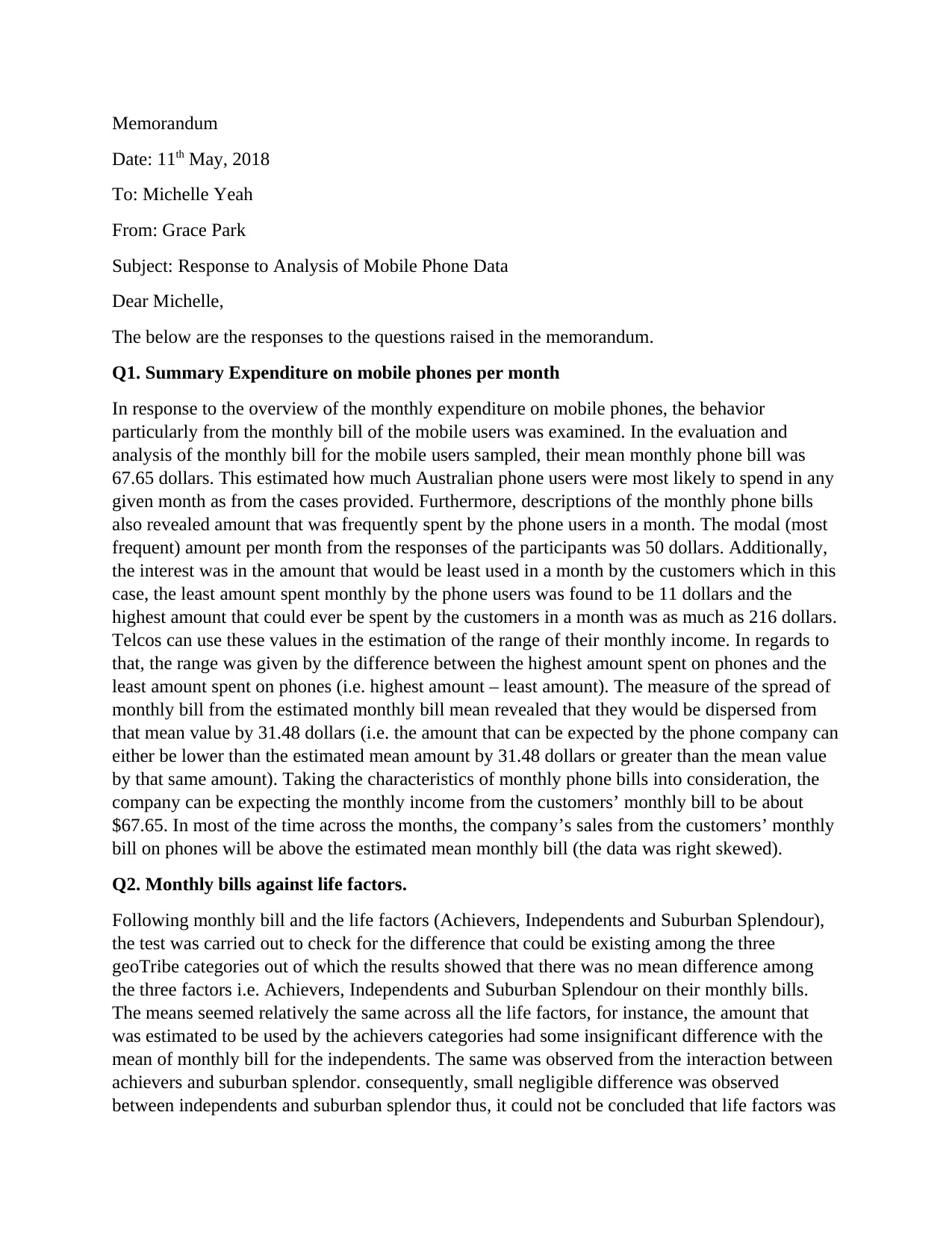
Memorandum
Date: 11th May, 2018
To: Michelle Yeah
From: Grace Park
Subject: Response to Analysis of Mobile Phone Data
Dear Michelle,
The below are the responses to the questions raised in the memorandum.
Q1. Summary Expenditure on mobile phones per month
In response to the overview of the monthly expenditure on mobile phones, the behavior
particularly from the monthly bill of the mobile users was examined. In the evaluation and
analysis of the monthly bill for the mobile users sampled, their mean monthly phone bill was
67.65 dollars. This estimated how much Australian phone users were most likely to spend in any
given month as from the cases provided. Furthermore, descriptions of the monthly phone bills
also revealed amount that was frequently spent by the phone users in a month. The modal (most
frequent) amount per month from the responses of the participants was 50 dollars. Additionally,
the interest was in the amount that would be least used in a month by the customers which in this
case, the least amount spent monthly by the phone users was found to be 11 dollars and the
highest amount that could ever be spent by the customers in a month was as much as 216 dollars.
Telcos can use these values in the estimation of the range of their monthly income. In regards to
that, the range was given by the difference between the highest amount spent on phones and the
least amount spent on phones (i.e. highest amount – least amount). The measure of the spread of
monthly bill from the estimated monthly bill mean revealed that they would be dispersed from
that mean value by 31.48 dollars (i.e. the amount that can be expected by the phone company can
either be lower than the estimated mean amount by 31.48 dollars or greater than the mean value
by that same amount). Taking the characteristics of monthly phone bills into consideration, the
company can be expecting the monthly income from the customers’ monthly bill to be about
$67.65. In most of the time across the months, the company’s sales from the customers’ monthly
bill on phones will be above the estimated mean monthly bill (the data was right skewed).
Q2. Monthly bills against life factors.
Following monthly bill and the life factors (Achievers, Independents and Suburban Splendour),
the test was carried out to check for the difference that could be existing among the three
geoTribe categories out of which the results showed that there was no mean difference among
the three factors i.e. Achievers, Independents and Suburban Splendour on their monthly bills.
The means seemed relatively the same across all the life factors, for instance, the amount that
was estimated to be used by the achievers categories had some insignificant difference with the
mean of monthly bill for the independents. The same was observed from the interaction between
achievers and suburban splendor. consequently, small negligible difference was observed
between independents and suburban splendor thus, it could not be concluded that life factors was
Date: 11th May, 2018
To: Michelle Yeah
From: Grace Park
Subject: Response to Analysis of Mobile Phone Data
Dear Michelle,
The below are the responses to the questions raised in the memorandum.
Q1. Summary Expenditure on mobile phones per month
In response to the overview of the monthly expenditure on mobile phones, the behavior
particularly from the monthly bill of the mobile users was examined. In the evaluation and
analysis of the monthly bill for the mobile users sampled, their mean monthly phone bill was
67.65 dollars. This estimated how much Australian phone users were most likely to spend in any
given month as from the cases provided. Furthermore, descriptions of the monthly phone bills
also revealed amount that was frequently spent by the phone users in a month. The modal (most
frequent) amount per month from the responses of the participants was 50 dollars. Additionally,
the interest was in the amount that would be least used in a month by the customers which in this
case, the least amount spent monthly by the phone users was found to be 11 dollars and the
highest amount that could ever be spent by the customers in a month was as much as 216 dollars.
Telcos can use these values in the estimation of the range of their monthly income. In regards to
that, the range was given by the difference between the highest amount spent on phones and the
least amount spent on phones (i.e. highest amount – least amount). The measure of the spread of
monthly bill from the estimated monthly bill mean revealed that they would be dispersed from
that mean value by 31.48 dollars (i.e. the amount that can be expected by the phone company can
either be lower than the estimated mean amount by 31.48 dollars or greater than the mean value
by that same amount). Taking the characteristics of monthly phone bills into consideration, the
company can be expecting the monthly income from the customers’ monthly bill to be about
$67.65. In most of the time across the months, the company’s sales from the customers’ monthly
bill on phones will be above the estimated mean monthly bill (the data was right skewed).
Q2. Monthly bills against life factors.
Following monthly bill and the life factors (Achievers, Independents and Suburban Splendour),
the test was carried out to check for the difference that could be existing among the three
geoTribe categories out of which the results showed that there was no mean difference among
the three factors i.e. Achievers, Independents and Suburban Splendour on their monthly bills.
The means seemed relatively the same across all the life factors, for instance, the amount that
was estimated to be used by the achievers categories had some insignificant difference with the
mean of monthly bill for the independents. The same was observed from the interaction between
achievers and suburban splendor. consequently, small negligible difference was observed
between independents and suburban splendor thus, it could not be concluded that life factors was
Paraphrase This Document
Need a fresh take? Get an instant paraphrase of this document with our AI Paraphraser
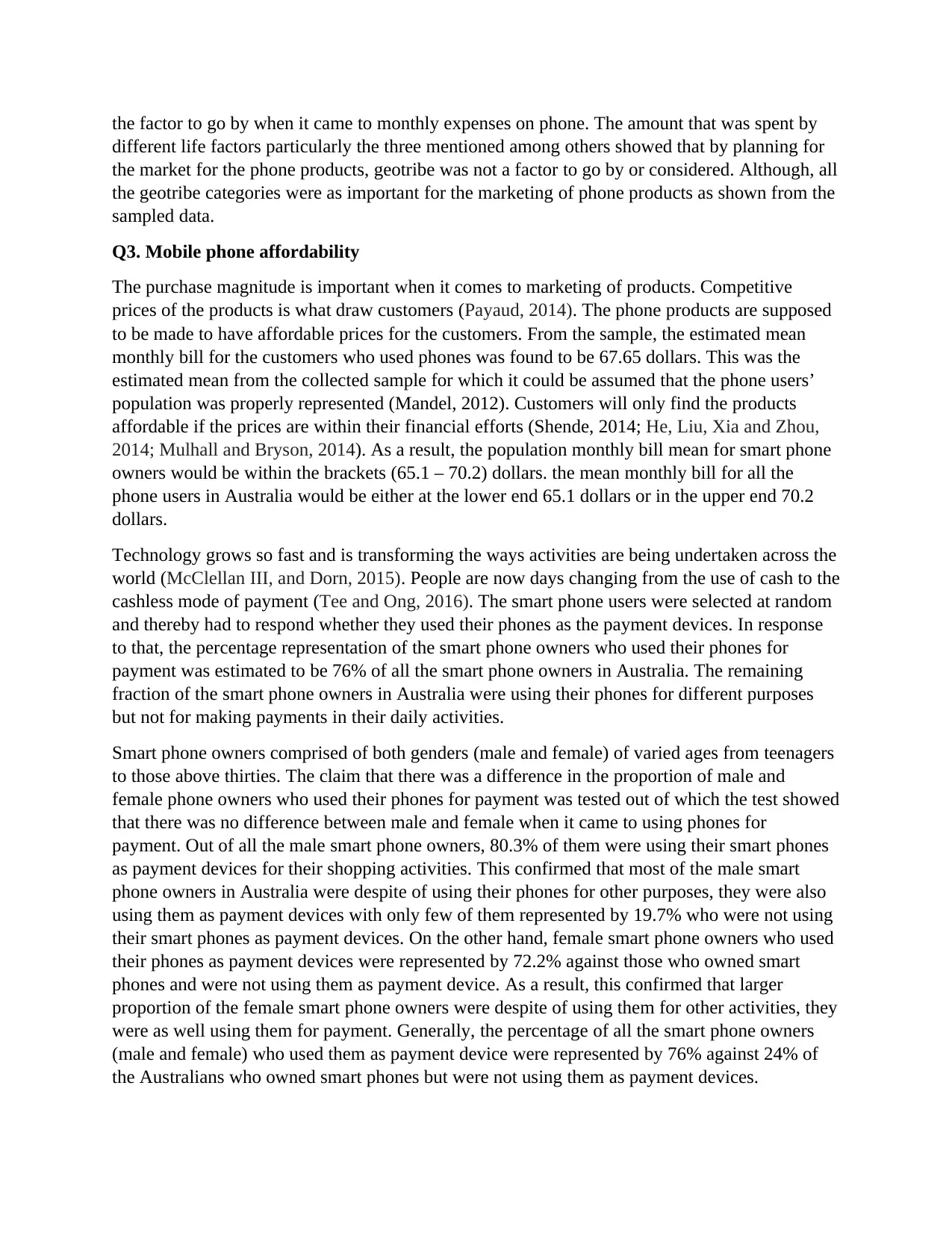
the factor to go by when it came to monthly expenses on phone. The amount that was spent by
different life factors particularly the three mentioned among others showed that by planning for
the market for the phone products, geotribe was not a factor to go by or considered. Although, all
the geotribe categories were as important for the marketing of phone products as shown from the
sampled data.
Q3. Mobile phone affordability
The purchase magnitude is important when it comes to marketing of products. Competitive
prices of the products is what draw customers (Payaud, 2014). The phone products are supposed
to be made to have affordable prices for the customers. From the sample, the estimated mean
monthly bill for the customers who used phones was found to be 67.65 dollars. This was the
estimated mean from the collected sample for which it could be assumed that the phone users’
population was properly represented (Mandel, 2012). Customers will only find the products
affordable if the prices are within their financial efforts (Shende, 2014; He, Liu, Xia and Zhou,
2014; Mulhall and Bryson, 2014). As a result, the population monthly bill mean for smart phone
owners would be within the brackets (65.1 – 70.2) dollars. the mean monthly bill for all the
phone users in Australia would be either at the lower end 65.1 dollars or in the upper end 70.2
dollars.
Technology grows so fast and is transforming the ways activities are being undertaken across the
world (McClellan III, and Dorn, 2015). People are now days changing from the use of cash to the
cashless mode of payment (Tee and Ong, 2016). The smart phone users were selected at random
and thereby had to respond whether they used their phones as the payment devices. In response
to that, the percentage representation of the smart phone owners who used their phones for
payment was estimated to be 76% of all the smart phone owners in Australia. The remaining
fraction of the smart phone owners in Australia were using their phones for different purposes
but not for making payments in their daily activities.
Smart phone owners comprised of both genders (male and female) of varied ages from teenagers
to those above thirties. The claim that there was a difference in the proportion of male and
female phone owners who used their phones for payment was tested out of which the test showed
that there was no difference between male and female when it came to using phones for
payment. Out of all the male smart phone owners, 80.3% of them were using their smart phones
as payment devices for their shopping activities. This confirmed that most of the male smart
phone owners in Australia were despite of using their phones for other purposes, they were also
using them as payment devices with only few of them represented by 19.7% who were not using
their smart phones as payment devices. On the other hand, female smart phone owners who used
their phones as payment devices were represented by 72.2% against those who owned smart
phones and were not using them as payment device. As a result, this confirmed that larger
proportion of the female smart phone owners were despite of using them for other activities, they
were as well using them for payment. Generally, the percentage of all the smart phone owners
(male and female) who used them as payment device were represented by 76% against 24% of
the Australians who owned smart phones but were not using them as payment devices.
different life factors particularly the three mentioned among others showed that by planning for
the market for the phone products, geotribe was not a factor to go by or considered. Although, all
the geotribe categories were as important for the marketing of phone products as shown from the
sampled data.
Q3. Mobile phone affordability
The purchase magnitude is important when it comes to marketing of products. Competitive
prices of the products is what draw customers (Payaud, 2014). The phone products are supposed
to be made to have affordable prices for the customers. From the sample, the estimated mean
monthly bill for the customers who used phones was found to be 67.65 dollars. This was the
estimated mean from the collected sample for which it could be assumed that the phone users’
population was properly represented (Mandel, 2012). Customers will only find the products
affordable if the prices are within their financial efforts (Shende, 2014; He, Liu, Xia and Zhou,
2014; Mulhall and Bryson, 2014). As a result, the population monthly bill mean for smart phone
owners would be within the brackets (65.1 – 70.2) dollars. the mean monthly bill for all the
phone users in Australia would be either at the lower end 65.1 dollars or in the upper end 70.2
dollars.
Technology grows so fast and is transforming the ways activities are being undertaken across the
world (McClellan III, and Dorn, 2015). People are now days changing from the use of cash to the
cashless mode of payment (Tee and Ong, 2016). The smart phone users were selected at random
and thereby had to respond whether they used their phones as the payment devices. In response
to that, the percentage representation of the smart phone owners who used their phones for
payment was estimated to be 76% of all the smart phone owners in Australia. The remaining
fraction of the smart phone owners in Australia were using their phones for different purposes
but not for making payments in their daily activities.
Smart phone owners comprised of both genders (male and female) of varied ages from teenagers
to those above thirties. The claim that there was a difference in the proportion of male and
female phone owners who used their phones for payment was tested out of which the test showed
that there was no difference between male and female when it came to using phones for
payment. Out of all the male smart phone owners, 80.3% of them were using their smart phones
as payment devices for their shopping activities. This confirmed that most of the male smart
phone owners in Australia were despite of using their phones for other purposes, they were also
using them as payment devices with only few of them represented by 19.7% who were not using
their smart phones as payment devices. On the other hand, female smart phone owners who used
their phones as payment devices were represented by 72.2% against those who owned smart
phones and were not using them as payment device. As a result, this confirmed that larger
proportion of the female smart phone owners were despite of using them for other activities, they
were as well using them for payment. Generally, the percentage of all the smart phone owners
(male and female) who used them as payment device were represented by 76% against 24% of
the Australians who owned smart phones but were not using them as payment devices.
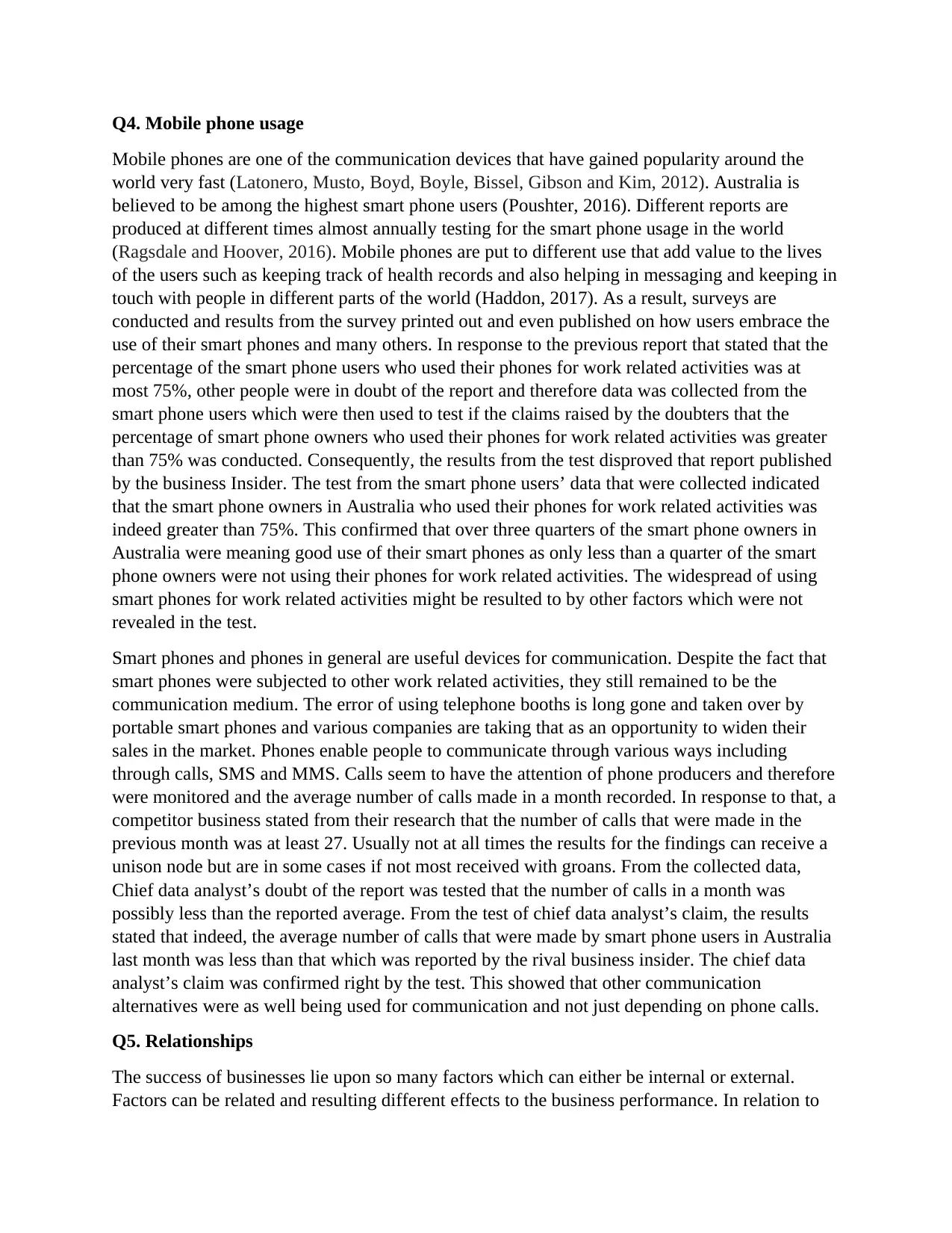
Q4. Mobile phone usage
Mobile phones are one of the communication devices that have gained popularity around the
world very fast (Latonero, Musto, Boyd, Boyle, Bissel, Gibson and Kim, 2012). Australia is
believed to be among the highest smart phone users (Poushter, 2016). Different reports are
produced at different times almost annually testing for the smart phone usage in the world
(Ragsdale and Hoover, 2016). Mobile phones are put to different use that add value to the lives
of the users such as keeping track of health records and also helping in messaging and keeping in
touch with people in different parts of the world (Haddon, 2017). As a result, surveys are
conducted and results from the survey printed out and even published on how users embrace the
use of their smart phones and many others. In response to the previous report that stated that the
percentage of the smart phone users who used their phones for work related activities was at
most 75%, other people were in doubt of the report and therefore data was collected from the
smart phone users which were then used to test if the claims raised by the doubters that the
percentage of smart phone owners who used their phones for work related activities was greater
than 75% was conducted. Consequently, the results from the test disproved that report published
by the business Insider. The test from the smart phone users’ data that were collected indicated
that the smart phone owners in Australia who used their phones for work related activities was
indeed greater than 75%. This confirmed that over three quarters of the smart phone owners in
Australia were meaning good use of their smart phones as only less than a quarter of the smart
phone owners were not using their phones for work related activities. The widespread of using
smart phones for work related activities might be resulted to by other factors which were not
revealed in the test.
Smart phones and phones in general are useful devices for communication. Despite the fact that
smart phones were subjected to other work related activities, they still remained to be the
communication medium. The error of using telephone booths is long gone and taken over by
portable smart phones and various companies are taking that as an opportunity to widen their
sales in the market. Phones enable people to communicate through various ways including
through calls, SMS and MMS. Calls seem to have the attention of phone producers and therefore
were monitored and the average number of calls made in a month recorded. In response to that, a
competitor business stated from their research that the number of calls that were made in the
previous month was at least 27. Usually not at all times the results for the findings can receive a
unison node but are in some cases if not most received with groans. From the collected data,
Chief data analyst’s doubt of the report was tested that the number of calls in a month was
possibly less than the reported average. From the test of chief data analyst’s claim, the results
stated that indeed, the average number of calls that were made by smart phone users in Australia
last month was less than that which was reported by the rival business insider. The chief data
analyst’s claim was confirmed right by the test. This showed that other communication
alternatives were as well being used for communication and not just depending on phone calls.
Q5. Relationships
The success of businesses lie upon so many factors which can either be internal or external.
Factors can be related and resulting different effects to the business performance. In relation to
Mobile phones are one of the communication devices that have gained popularity around the
world very fast (Latonero, Musto, Boyd, Boyle, Bissel, Gibson and Kim, 2012). Australia is
believed to be among the highest smart phone users (Poushter, 2016). Different reports are
produced at different times almost annually testing for the smart phone usage in the world
(Ragsdale and Hoover, 2016). Mobile phones are put to different use that add value to the lives
of the users such as keeping track of health records and also helping in messaging and keeping in
touch with people in different parts of the world (Haddon, 2017). As a result, surveys are
conducted and results from the survey printed out and even published on how users embrace the
use of their smart phones and many others. In response to the previous report that stated that the
percentage of the smart phone users who used their phones for work related activities was at
most 75%, other people were in doubt of the report and therefore data was collected from the
smart phone users which were then used to test if the claims raised by the doubters that the
percentage of smart phone owners who used their phones for work related activities was greater
than 75% was conducted. Consequently, the results from the test disproved that report published
by the business Insider. The test from the smart phone users’ data that were collected indicated
that the smart phone owners in Australia who used their phones for work related activities was
indeed greater than 75%. This confirmed that over three quarters of the smart phone owners in
Australia were meaning good use of their smart phones as only less than a quarter of the smart
phone owners were not using their phones for work related activities. The widespread of using
smart phones for work related activities might be resulted to by other factors which were not
revealed in the test.
Smart phones and phones in general are useful devices for communication. Despite the fact that
smart phones were subjected to other work related activities, they still remained to be the
communication medium. The error of using telephone booths is long gone and taken over by
portable smart phones and various companies are taking that as an opportunity to widen their
sales in the market. Phones enable people to communicate through various ways including
through calls, SMS and MMS. Calls seem to have the attention of phone producers and therefore
were monitored and the average number of calls made in a month recorded. In response to that, a
competitor business stated from their research that the number of calls that were made in the
previous month was at least 27. Usually not at all times the results for the findings can receive a
unison node but are in some cases if not most received with groans. From the collected data,
Chief data analyst’s doubt of the report was tested that the number of calls in a month was
possibly less than the reported average. From the test of chief data analyst’s claim, the results
stated that indeed, the average number of calls that were made by smart phone users in Australia
last month was less than that which was reported by the rival business insider. The chief data
analyst’s claim was confirmed right by the test. This showed that other communication
alternatives were as well being used for communication and not just depending on phone calls.
Q5. Relationships
The success of businesses lie upon so many factors which can either be internal or external.
Factors can be related and resulting different effects to the business performance. In relation to
⊘ This is a preview!⊘
Do you want full access?
Subscribe today to unlock all pages.

Trusted by 1+ million students worldwide
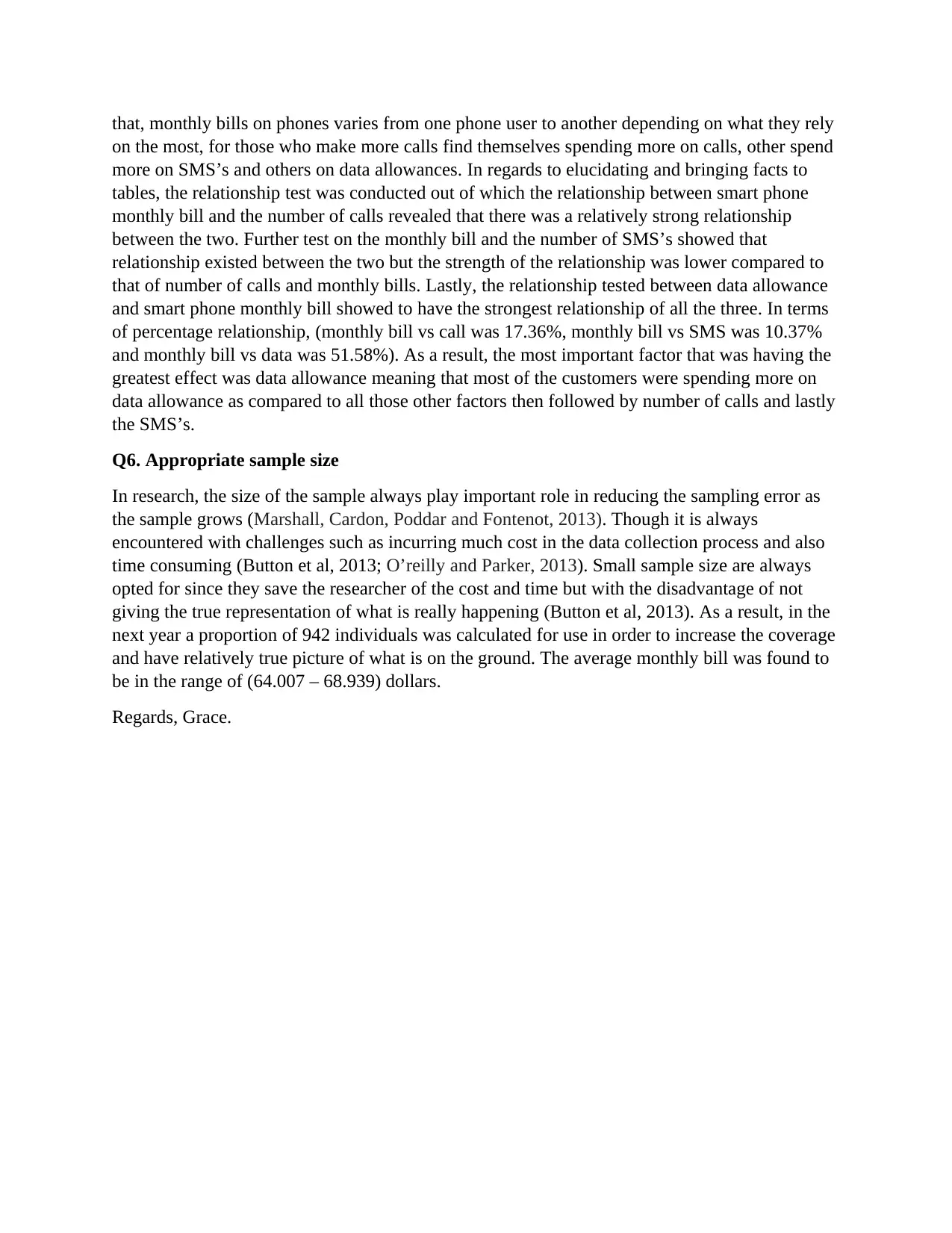
that, monthly bills on phones varies from one phone user to another depending on what they rely
on the most, for those who make more calls find themselves spending more on calls, other spend
more on SMS’s and others on data allowances. In regards to elucidating and bringing facts to
tables, the relationship test was conducted out of which the relationship between smart phone
monthly bill and the number of calls revealed that there was a relatively strong relationship
between the two. Further test on the monthly bill and the number of SMS’s showed that
relationship existed between the two but the strength of the relationship was lower compared to
that of number of calls and monthly bills. Lastly, the relationship tested between data allowance
and smart phone monthly bill showed to have the strongest relationship of all the three. In terms
of percentage relationship, (monthly bill vs call was 17.36%, monthly bill vs SMS was 10.37%
and monthly bill vs data was 51.58%). As a result, the most important factor that was having the
greatest effect was data allowance meaning that most of the customers were spending more on
data allowance as compared to all those other factors then followed by number of calls and lastly
the SMS’s.
Q6. Appropriate sample size
In research, the size of the sample always play important role in reducing the sampling error as
the sample grows (Marshall, Cardon, Poddar and Fontenot, 2013). Though it is always
encountered with challenges such as incurring much cost in the data collection process and also
time consuming (Button et al, 2013; O’reilly and Parker, 2013). Small sample size are always
opted for since they save the researcher of the cost and time but with the disadvantage of not
giving the true representation of what is really happening (Button et al, 2013). As a result, in the
next year a proportion of 942 individuals was calculated for use in order to increase the coverage
and have relatively true picture of what is on the ground. The average monthly bill was found to
be in the range of (64.007 – 68.939) dollars.
Regards, Grace.
on the most, for those who make more calls find themselves spending more on calls, other spend
more on SMS’s and others on data allowances. In regards to elucidating and bringing facts to
tables, the relationship test was conducted out of which the relationship between smart phone
monthly bill and the number of calls revealed that there was a relatively strong relationship
between the two. Further test on the monthly bill and the number of SMS’s showed that
relationship existed between the two but the strength of the relationship was lower compared to
that of number of calls and monthly bills. Lastly, the relationship tested between data allowance
and smart phone monthly bill showed to have the strongest relationship of all the three. In terms
of percentage relationship, (monthly bill vs call was 17.36%, monthly bill vs SMS was 10.37%
and monthly bill vs data was 51.58%). As a result, the most important factor that was having the
greatest effect was data allowance meaning that most of the customers were spending more on
data allowance as compared to all those other factors then followed by number of calls and lastly
the SMS’s.
Q6. Appropriate sample size
In research, the size of the sample always play important role in reducing the sampling error as
the sample grows (Marshall, Cardon, Poddar and Fontenot, 2013). Though it is always
encountered with challenges such as incurring much cost in the data collection process and also
time consuming (Button et al, 2013; O’reilly and Parker, 2013). Small sample size are always
opted for since they save the researcher of the cost and time but with the disadvantage of not
giving the true representation of what is really happening (Button et al, 2013). As a result, in the
next year a proportion of 942 individuals was calculated for use in order to increase the coverage
and have relatively true picture of what is on the ground. The average monthly bill was found to
be in the range of (64.007 – 68.939) dollars.
Regards, Grace.
Paraphrase This Document
Need a fresh take? Get an instant paraphrase of this document with our AI Paraphraser
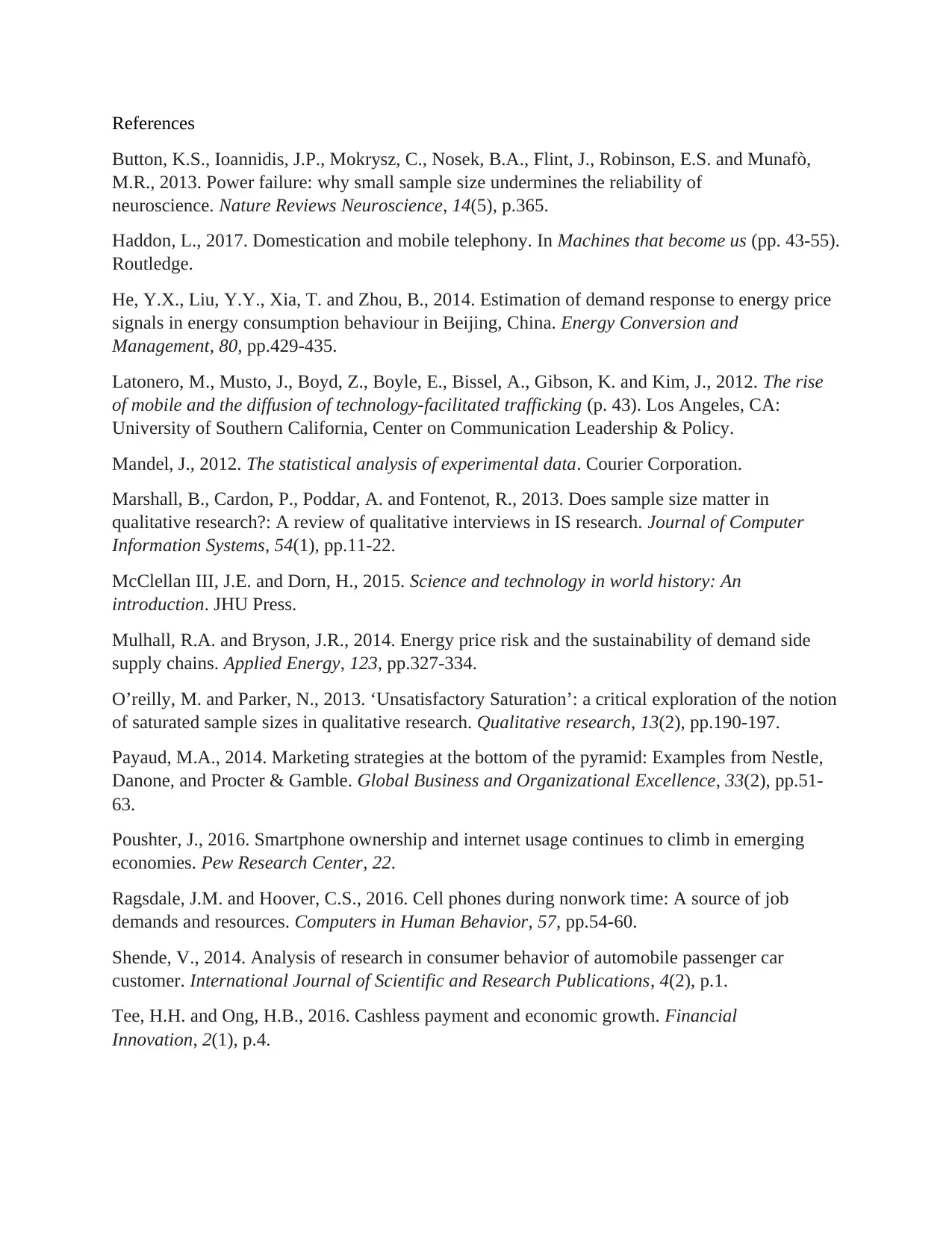
References
Button, K.S., Ioannidis, J.P., Mokrysz, C., Nosek, B.A., Flint, J., Robinson, E.S. and Munafò,
M.R., 2013. Power failure: why small sample size undermines the reliability of
neuroscience. Nature Reviews Neuroscience, 14(5), p.365.
Haddon, L., 2017. Domestication and mobile telephony. In Machines that become us (pp. 43-55).
Routledge.
He, Y.X., Liu, Y.Y., Xia, T. and Zhou, B., 2014. Estimation of demand response to energy price
signals in energy consumption behaviour in Beijing, China. Energy Conversion and
Management, 80, pp.429-435.
Latonero, M., Musto, J., Boyd, Z., Boyle, E., Bissel, A., Gibson, K. and Kim, J., 2012. The rise
of mobile and the diffusion of technology-facilitated trafficking (p. 43). Los Angeles, CA:
University of Southern California, Center on Communication Leadership & Policy.
Mandel, J., 2012. The statistical analysis of experimental data. Courier Corporation.
Marshall, B., Cardon, P., Poddar, A. and Fontenot, R., 2013. Does sample size matter in
qualitative research?: A review of qualitative interviews in IS research. Journal of Computer
Information Systems, 54(1), pp.11-22.
McClellan III, J.E. and Dorn, H., 2015. Science and technology in world history: An
introduction. JHU Press.
Mulhall, R.A. and Bryson, J.R., 2014. Energy price risk and the sustainability of demand side
supply chains. Applied Energy, 123, pp.327-334.
O’reilly, M. and Parker, N., 2013. ‘Unsatisfactory Saturation’: a critical exploration of the notion
of saturated sample sizes in qualitative research. Qualitative research, 13(2), pp.190-197.
Payaud, M.A., 2014. Marketing strategies at the bottom of the pyramid: Examples from Nestle,
Danone, and Procter & Gamble. Global Business and Organizational Excellence, 33(2), pp.51-
63.
Poushter, J., 2016. Smartphone ownership and internet usage continues to climb in emerging
economies. Pew Research Center, 22.
Ragsdale, J.M. and Hoover, C.S., 2016. Cell phones during nonwork time: A source of job
demands and resources. Computers in Human Behavior, 57, pp.54-60.
Shende, V., 2014. Analysis of research in consumer behavior of automobile passenger car
customer. International Journal of Scientific and Research Publications, 4(2), p.1.
Tee, H.H. and Ong, H.B., 2016. Cashless payment and economic growth. Financial
Innovation, 2(1), p.4.
Button, K.S., Ioannidis, J.P., Mokrysz, C., Nosek, B.A., Flint, J., Robinson, E.S. and Munafò,
M.R., 2013. Power failure: why small sample size undermines the reliability of
neuroscience. Nature Reviews Neuroscience, 14(5), p.365.
Haddon, L., 2017. Domestication and mobile telephony. In Machines that become us (pp. 43-55).
Routledge.
He, Y.X., Liu, Y.Y., Xia, T. and Zhou, B., 2014. Estimation of demand response to energy price
signals in energy consumption behaviour in Beijing, China. Energy Conversion and
Management, 80, pp.429-435.
Latonero, M., Musto, J., Boyd, Z., Boyle, E., Bissel, A., Gibson, K. and Kim, J., 2012. The rise
of mobile and the diffusion of technology-facilitated trafficking (p. 43). Los Angeles, CA:
University of Southern California, Center on Communication Leadership & Policy.
Mandel, J., 2012. The statistical analysis of experimental data. Courier Corporation.
Marshall, B., Cardon, P., Poddar, A. and Fontenot, R., 2013. Does sample size matter in
qualitative research?: A review of qualitative interviews in IS research. Journal of Computer
Information Systems, 54(1), pp.11-22.
McClellan III, J.E. and Dorn, H., 2015. Science and technology in world history: An
introduction. JHU Press.
Mulhall, R.A. and Bryson, J.R., 2014. Energy price risk and the sustainability of demand side
supply chains. Applied Energy, 123, pp.327-334.
O’reilly, M. and Parker, N., 2013. ‘Unsatisfactory Saturation’: a critical exploration of the notion
of saturated sample sizes in qualitative research. Qualitative research, 13(2), pp.190-197.
Payaud, M.A., 2014. Marketing strategies at the bottom of the pyramid: Examples from Nestle,
Danone, and Procter & Gamble. Global Business and Organizational Excellence, 33(2), pp.51-
63.
Poushter, J., 2016. Smartphone ownership and internet usage continues to climb in emerging
economies. Pew Research Center, 22.
Ragsdale, J.M. and Hoover, C.S., 2016. Cell phones during nonwork time: A source of job
demands and resources. Computers in Human Behavior, 57, pp.54-60.
Shende, V., 2014. Analysis of research in consumer behavior of automobile passenger car
customer. International Journal of Scientific and Research Publications, 4(2), p.1.
Tee, H.H. and Ong, H.B., 2016. Cashless payment and economic growth. Financial
Innovation, 2(1), p.4.
1 out of 5
Your All-in-One AI-Powered Toolkit for Academic Success.
+13062052269
info@desklib.com
Available 24*7 on WhatsApp / Email
![[object Object]](/_next/static/media/star-bottom.7253800d.svg)
Unlock your academic potential
Copyright © 2020–2025 A2Z Services. All Rights Reserved. Developed and managed by ZUCOL.
